

Story Index Page

By Adrian Jones [1992].
Based on Star Trek created by Gene Roddenberry.
Stories by: Adrian Jones and Andrew Brown, with invaluable assistance from Nick Cook, Sean Paul Teeling, Gene Hendricks, Keith R A DeCandido, Dayton Ward and David R George III.
Technical assistance by: Rick Sternbach, Doug Drexler, Andrew Probert, Nick Cook, Sean Paul Teeling, Alex Rosenzweig, Michael C. Rupprecht, Bernd Schneider, S. John Ross, Ex Astris Scientia and ASDB websites and Curt Danhauser.
For their inspiration, thank you to: Nick Meyer, Harve Bennett, Leonard Nimoy, Greg Bear, H G Wells, James Cameron, Ridley Scott, George Lucas, Steven Spielberg, Joss Whedon, Jeff Wayne, with Persis Khambatta and the other Star Trek actors, writers, behind-the-scenes staff and the fans that helped Gene's universe to go to warp...
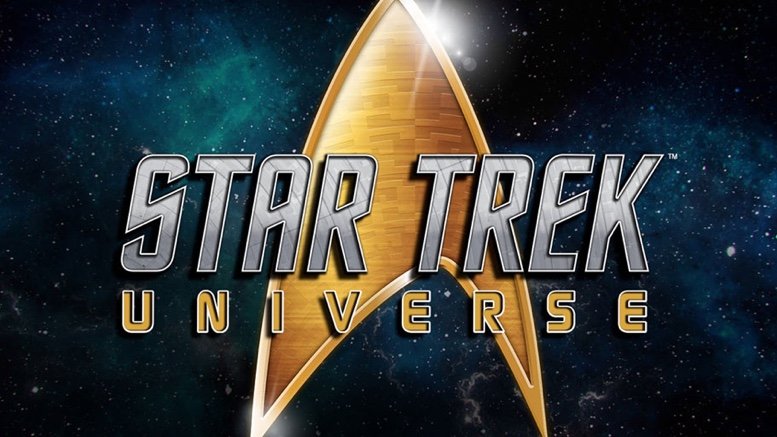
STAR TREK: The Interim Years - Anthology:
Star Trek: Grissom
Star Trek: Grissom - The Price of Virtue. (by Adrian Howard Jones and Andrew Brown)
Stardate 8134.6 - A Klingon invasion leads to a Federation liner rescuing refugees from the neutral zone border. Whilst the U.S.S. South Georgia works to prevent an intergalactic incident, Captain J. T. Estaban and the crew of the U.S.S. Grissom must work to uncover the truth behind the refugees, who they are and where they are from.
When the situation on the liner gets out of hand, Thor and the security operations personnel of the Grissom must work to resolve the situation without loss of life. What is the price of virtue? and can that price sometimes be too high?
Star Trek: Underworld
This looks for the first time at life in the Star Trek universe AWAY from Starfleet; what happens to those members of the Federation who either choose or are unable to join Starfleet? What is colonial life really like? This is about the ideals of the Federation in the outer colonies where people LIVE on the final frontier. There is substantially less of the technology and glamour of the core worlds. These are the self-reliant, self-built homesteads that farm, mine, manufacture or research for the Federation.
For those children growing up on these colonies the choice is a stark one: either follow in the path your parents have determinesd and live a life of building your colony: something that will take generations to achieve, or strike out on your own to either join Starfleet, the merchant marine or go into the private sector. Get a ship of your own and trade where you can. Join the Orion Syndicate or go independent at your own risk. Go for the big win and avoid the patrol ships of Starfleet. se your wits to eveade their superior sensors, speed, weapons and training.
Harry Mudd, Thadium Okona and Kassidy Yates all took this lifestyle to varying degrees with the Stella, Erstwhile and Xhosa as their loyal steeds. This series will look at the 'other' side of the Star Trek universe from the one that we're used to. Looking at illegal trading, trafficking, narcotics and the realities of colonial life away from the core worlds and founding colonies like Deneva and the Rigel Colonies. The truth is, like those who built log cabins in Canada, Alaska or Siberia, this is a harsh life that will determine the path for your children, grandchildren and great-grand children. Is it fair to do that? Not to mention the most important question that Star Trek really hasn't answered satisfactorily: What do people do that don't join Starfleet...? Away from those Star Trek tech Starfleet bases and core worlds, there isn't all the fancy tech beyond a 23rd Century generator, recycler and food synthesiser. The rest, with help from Starfleet, is up to you.
The whole point here is to do like the musical 'Wicked' and turn the Star Trek universe on its head. We've seen for over fifty years the universe form the perspective of Starfleet. Now it's time to see the perspective from the average person in the Federation. Where the people actually have a small freighter and AVOID Starfleet ships. This will explore criminality and the reasons behind it in the 23rd Century. It will also look at how much has changed - and how much really hasn't - since the 21st Century. My visit to McBride, British Columbia last year showed the realities of going back to basics and building your own log cabin. This is about starting from nothing. Sinking a well, digging an outhouse for sanitation and then building your home by hand from scratch. This takes a lot of time and energy. Whilst in the Star Trek universe they have technology, you don't have pop-up houses. This is out on the frontier. Most colonies are started for settling people, farming crops, mining dilithium or other minerals or performing research - either away from the public or where the item of research is available.
Life on the colonies isn't really any different from life in rural Canada, Alaska or Siberia now. Beyond the supertech power source for your home, the 100% recycler/food processor and fabricator you still have the same sort of possessions that someone out there would have now. There are no nightclubs or holiday resorts. Starfleet barely sends an Okinawa class corvette/frigate every now and then to see how you are. Transports arrive periodically with either more colonists, goods or supplies that are energy intensive to be replicating constantly. This is about daily hard work of taming a 100% wild planet, farming or mining or working the research station whilst clearing ground and building homes and bars. Home-schooling and residing either in home or at your place of work is the reality of colonial life. Barn-dances and home entertainment is the order of the day. Occasionally perhaps a Starfleet ship will come for shoreleave. Here, the values of Gene Roddenberry's Star Trek are put to the ultimate test. After all, as Ben Sisko once said, it's easy to be a saint in Paradise...
This also shows the Federation vision of the frontier - like the American Frontier of the 19th Century. Starbases like 77 and 111, facilities like Station Psi Five or Station Hurley One that conduct research - some of which is classified. Compare and contrast the lives and viewpoints. The Orion Syndicate, the drugs, the violence and the colonies living on the brink of the Federation boundaries. Their lives interlocked in a way that many don't see. An indefenceable, unimaginably vast border that is porous to immigration, trafficking and crime. Only ships like the Interceptor, Sheppey and other patrol and defender vessels stand in the way on this Final Frontier.
A series that won't hide away from the brutality of real life in the 23rd Century, that Tasha Yar's story would have told about Turkana IV - a FAILED Federation colony that the Federation Council allowed to fail on their watch. No starships rescuing them from drugs and violence as the tales of Yar to Wesley Crusher showed. Inspired by the Australian 5-season series "Sea Patrol", this shows life onbard the smallest patrol ships of Starfleet.
Star Trek: Nine Pillars of Romulus
The strategic, long game Romulans. A series covering the plotting, strength and honour of the Romulans and their Star Empire. This shows the pillars of power: th Emperor (and Empress), the Praetor, Senate, Continuing Committee / Party, Tal Shiar, Department of Education, Military, Qowat Milat and Praetorian Guard. It shows the dance of power and succession between them. The winners and the losers. This truly is Game of Thrones meets Star Trek. It deals with Roddenberrian laws never seen before: dealing with others who are different, with different laws, customs and values. Respecting those differences, despite not agreeing with them. Not wanting regime change. Not wanting them to be like us. Seeing the Star Trek universe from another angle.
1.01 - The Glory of Romulus - Pilot episode that deals with Romulus at its height in the 2290s, prior to the destruction by the explosion of Hobus. An emphasis on the Senate and Praetor.
1.02 - Guilded Cage - The Palatine Palace introduced as the Forbidden City. Introduction of the Emperor and Empress.
1.03 - The Power of Shadows - The Continuing Committee revealed as the true power. Dictating the media and politics.
1.04 - Sword and Shield - The Tal Shiar depicted as the Kempeitai / Stasi / Guoanbu.
1.05 - The Pen is mightier than the Sword - the Department of Education and their propaganda and educational curriculum.
Star Trek: Excelsior
Mini-series Season 1 2293
1.01 – Brave New World Intro, Khitomer and aftermath. After the mediocre Flashback script by Brannon Braga, which he himself admitted was the weaker script for the 30th Anniversary, a ST: Excelsior mini-series would need a PROPER pilot episode. This would recap the events of ST: VI and what happened after the Excelsior banked away off-screen in ST: TUC. This is the scene-setter with the Khitomer Accords and characters from both the Federation and Klingon Empire.
1.01 and 1.02 – Brave New World
1.03 – Lions of the Empire
1.04 – Imperious Rex - Chancellor Azetbur story.
1.05 – The Art of Listening- Ambassador Spock story.
1.06 – Ascension - House of J'tal and General Qo'mar story.
1.07 – At the Edge of Honour - Sulu and the Excelsior meet up with Kang for the first time since the Azure Nebula Incident and he's in a very dark place... Each of the three original Klingons would be an archetype of the species. Kang is the warrior, who is out following his blood oath to exact vengeance on the Albino. He doesn't care who gets in the way and how many - this is Kang doing what he does best: killing. The question is can he stop himself becoming just a mindless murderer instead of a Klingon warrior? Does he still remember where the line is drawn?
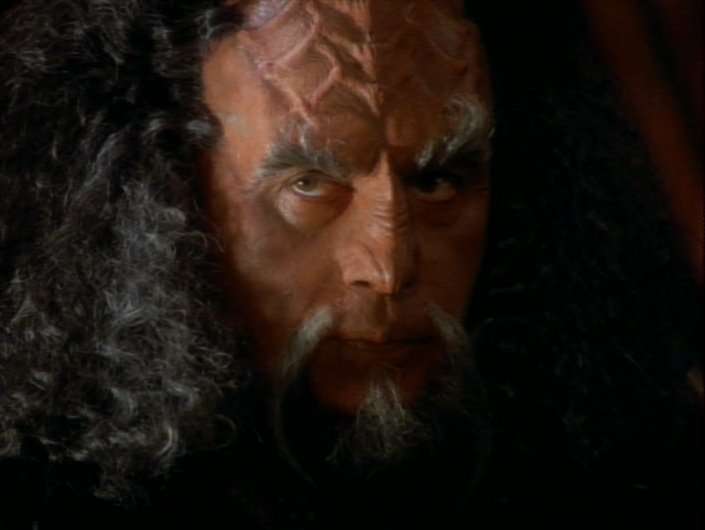
1.08 – Encirclement - seeing the Trek universe from a Klingon-centric viewpoint.
1.09 – Mudd junior – follow up to the never-written ST: Phase 2 episode Mudd & Son. Before the joy of Rainn Wilson there was the Harry Mudd of Roger C. Carmel. This is a lighter tone episode about the son of Mudd, yet also deals with the Orions and how they exploit the fall of the Klingon Empire. Strangely a similar turn to what the Orions seem to be doing with Mudd in ST: Discovery.
1.10 – Fracture - Ch'ramak and Terajun.
Season 2 – 2294
2.01 – Echoes of Tian Nan Men - Azetbur sends in the fleet. Klingon version of Prague Spring.
2.02 – Fallen Hero. The Excelsior catches up with Kor, a hero who's fallen into a bottle after his firstborn son was murdered. Archetype number 2 for the Klingons: the alcoholic. Alcoholism is prevalent in the former Soviet Union and modern-day Russia. This is also the case in the Klingon Empire with Blood Wine a staple of TNG, VOY and especially DS9. In the DS9 season 5 opener, Apocalypse Rising, the Order of the Batleth induction process is seen and drinking is a massive part, even promoted. Some Klingons will take this too far. Kor is also seen in DS9 Blood Oath opening part as a drunk. This is perfect for this episode where Kor show himself to be a drunk after the death of his son. A cruel drunk. A morality tale of how alcoholism destroys people and their families. Star Trek does this occasionally and this time it's a Klingon's tale.
Kor still has his ancient D-5 battlecruiser Klothos. The ship has been modified extensively over the decades; she was one of the first ships modified with a cloaking device, as the Bird of Prey-style copper chin guard and cabling over the aft hull testifies. The sensors, disruptors and torpedo systems have been similarly upgraded. Author's note: like the trialled 1990s upgrade for a T-55 Soviet tank. She may not look pretty with all the modifications, however the Klothos is one of the most advanced D-5 warships in the IKN.
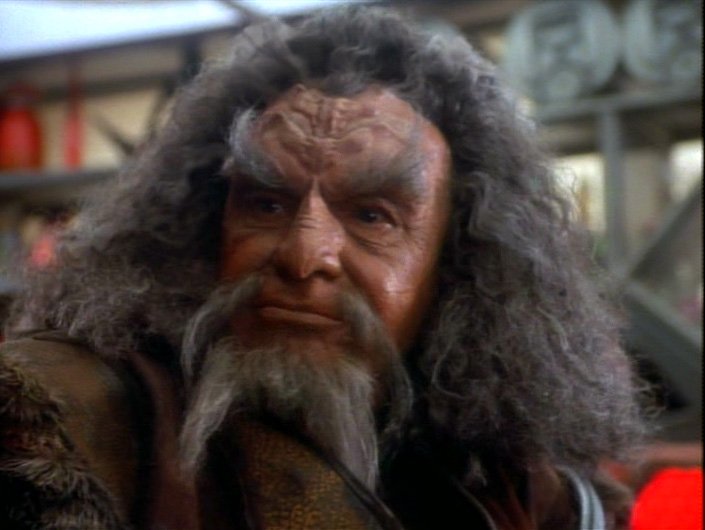
2.03 – Organia – revisiting the world that foresaw the Khitomer Accords... I hate god-type beings. They are lazy story devices and our heroes cannot really defeat people like Trelane, Organians, Excalbians and Q. Dull. But for the story point here, important to show the Organians have left. This is why Kruge could attack the Grissom etc.
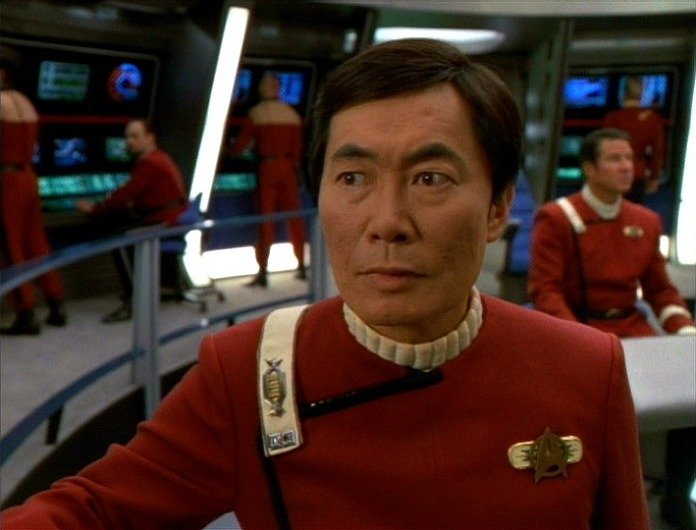 2.04 – Our Generation – Sulu meets up with Koloth, who's not happy with the Khitomer Accords. The third Klingon archetype: the honourable noble. Koloth is what Kor evolved into in DS9, a noble who was descended from the blood of Kahless. William Campbell came across both in Trouble with Tribbles and Blood Oath as the aristocratic Klingon. The political beast who has connections through blood and his House. He knew Kang and Kor, but also was in with Kesh, Gorkon, Korrd and Chang. Why would he trust humans over these Klingons he's known for years when all Kirk did was put Tribbles onto his ship and humiliated him? The title comes from Gorkon's line "If there is to be a Brave New World, our generation is going to have the hardest time living in it". This story acts as a primer for what happens next...
2.04 – Our Generation – Sulu meets up with Koloth, who's not happy with the Khitomer Accords. The third Klingon archetype: the honourable noble. Koloth is what Kor evolved into in DS9, a noble who was descended from the blood of Kahless. William Campbell came across both in Trouble with Tribbles and Blood Oath as the aristocratic Klingon. The political beast who has connections through blood and his House. He knew Kang and Kor, but also was in with Kesh, Gorkon, Korrd and Chang. Why would he trust humans over these Klingons he's known for years when all Kirk did was put Tribbles onto his ship and humiliated him? The title comes from Gorkon's line "If there is to be a Brave New World, our generation is going to have the hardest time living in it". This story acts as a primer for what happens next...
2.05 - Ch'ramak - The collapse of the Empire, as predicted by Spock, has begun! The fall of the Warsaw Pact and Soviet Union in 1992 preceded civil wars in Georgia and many of the 'stans countries. Chechnya was a warzone twice in the 1990s and early 2000s. This is the Afghanistan and Chechnya of the Klingon Empire and reflects what has happened after Praxis has brought the Empire low. Spock predicted the break-up of the Klingon Empire and this is where is really starts.
2.06 – Destinies - Sulu and the U.S.S. Excelsior pick up Ambassador Spock for a meeting on Qo'noS with Chancellor Azetbur. There is a coup on the Klingon Empire. And it is led by Koloth! Cliffhanger ending. I wanted people to be invested in who topples Azetbur in a coup. It couldn't be a new character introduced for the job, it HAD to be someone we knew and wouldn't totally expect. Koloth fit the bill as a proud, loyal Klingon that doesn't want the Empire to surrender. He saw Chang as a loyal Klingon and quite frankly everything seems to be benefitting the Federation, not the Empire. And Azetbur being crowned like a Klingon Queen Elizabeth makes Gorkon feel more like the Klingon Henry VIII than Abraham Lincoln. This also had to have some reason for the Excelsior crew to both know the culprit and also have a way out of this one.
Star Trek: Solace
Mini-series 2295
1.01 - Infection
1.02 - Incubation
1.03 - Vector
1.04 - Contamination
1.05 - Pandemic
1.06 - Quarantine
1.07 - Depersonalisation
1.08 - Crash
1.09 - Recovery
Star Trek: Nimrod
Star Trek: Investigator
1. Day 268.
2. Anomaly.
3. The Object.
4. Said the spider the the fly.
5. Headaches.
6. Leap of Faith.
7. Geobiology.
8. Heart of Stone.
9. A New Kind of Mind.
10. Revelations.
Star Trek: Montrose
Star Trek: Sheffield
2312 - Year One
The Great Game
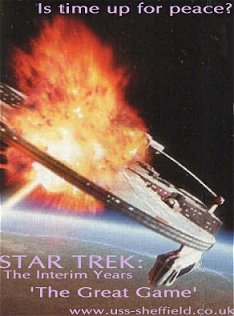 The year is 2312, nineteen years after the explosion of the Klingon key energy production facility on the moon Praxis. Barely months after the confrontation with the Romulans came to a violent and bloody head at Tomed, so the Klingon Empire is suddenly thrown into disarray by the assassination of Chancellor Azetbur.
The year is 2312, nineteen years after the explosion of the Klingon key energy production facility on the moon Praxis. Barely months after the confrontation with the Romulans came to a violent and bloody head at Tomed, so the Klingon Empire is suddenly thrown into disarray by the assassination of Chancellor Azetbur.
Captain Nathaniel Hawkins and the crew of the U.S.S. Sheffield begin an epic three-year mission to decipher the Beta Quadrant, explore the major and minor powers that reside in this mysterious and dangerous corner of space. Winds of change are blowing both in Starfleet and in this quadrant; the mission of the Sheffield is to discover which ways those winds are blowing, before it is too late.
The first port of call is to Nimbus III the 'Planet of Galactic Peace' where the retiring Federation ambassador, St. John Talbot, will brief the crew on the races and events that have gone unseen in the shadows. There are many secrets from the past that are about to be brought into the light, some from very unexpected places.
E-World
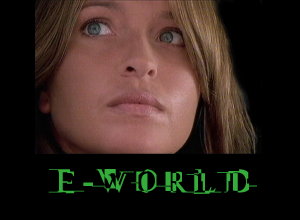 The U.S.S. Sheffield crew beam down to a planet where there are ruins of a 21st Century-equivalent civilisation. Trees, wildlife - all have reclaimed the planet and the civilisation has apparently long gone. All that still exists are a neural network of aging computers, power sources and droids to maintain them.
The U.S.S. Sheffield crew beam down to a planet where there are ruins of a 21st Century-equivalent civilisation. Trees, wildlife - all have reclaimed the planet and the civilisation has apparently long gone. All that still exists are a neural network of aging computers, power sources and droids to maintain them.
An abandoned hospital leads Doctor A'Ochak into discovering a computer jack for linking into the computer network. In an attempt to find out about the lost civilisation, Lieutenant Kara Fox uses her dataport to log into the system.
Once in the system, Kara discovers a virtual world. The population transferred their personalities into the network as their addiction to the limitless possibilities of the internet made them neglect the real world more and more. Eventually the whole population was transferred.
Now the system is breaking down, the E-World is at risk. Can the crew of the U.S.S. Sheffield save them? Should they be saved? or must the Prime Directive condemn the race to their fate...?
"...The Prime Directive is not just a set of rules; it is a philosophy... and a very correct one. History has proven again and again that whenever mankind interferes with a less developed civilization, no matter how well intentioned that interference may be, the results are invariably disastrous."
- Captain Picard - TNG: "Symbiosis"
Torments of Tantalus
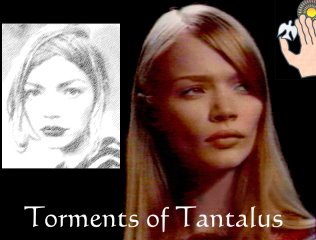 The Final Frontier is a realm of the fantastic, the mysterious and the terrible. For those crews of starships, their pioneers and explorers, history assures them of a place. For those lost along the way, there are monuments and services of remembrance. But what is there for those wounded by what they found, saw or experienced?
The Final Frontier is a realm of the fantastic, the mysterious and the terrible. For those crews of starships, their pioneers and explorers, history assures them of a place. For those lost along the way, there are monuments and services of remembrance. But what is there for those wounded by what they found, saw or experienced?
-Ensign Judith Peers
A call from the past brings Lieutenant Commander Judith Peers back to her first assignment: Nirvana Colony. Nirvana Rehabilitation Colony is the home of the mentally challenged, with maximum security to prevent the escape of those dangerous ones residing there.
It was here as an ensign that Peers first dealt with a patient, formerly of Starfleet, who had as much mystery surrounding them as there was known about them. No one had managed to get through the wall of madness. Mind melds had failed disasterously and now it is Peers who is being asked to return by name - by the patient themself.
What deep secret is the patient hiding? Is their some method to the madness of this former Starfleet Petty Officer, or is the tormented now the tormentor? Peers must work her way through the minefield of mind games to find out the answer.
'All these drugs, all this therapy - perhaps my mind is freer than yours'.
Asylum
Overcrowding. Ragged refugees fighting over what resources there are; overstretched immigration officials and bureaucracy that cannot keep up with demand. The United Federation of Planets attracts millions of refugees and asylum-seekers every year, intercepted by the dedicated frigate and patrol vessels on the long and convoluted border. Despite replication technology and a food surplus, the system is at breaking point.
These new arrivals go to the Gateway Colony and other similar facilities. With controversial races arriving such as the Ch'ramaki, with a history of terrorism and connections to criminal activities both outside and within the Federation, the colonies are under review as the dawning of the 24th Century brings with it new challenges and revives old problems.
Dark Territory
Stardate 13598.5 - the U.S.S. Sheffield prepares for her mission into Klingon space. Her first call is a backwater system on the border, a world last visited by the U.S.S. Fearless five years before.
2313 - Year Two
Tears in the Orphan's Eyes
The Ch'ramaki homeworld has been raped and pillaged for the last decade by the Klingons. The klingons have asserted their Kahlessian philosophy stronger than before via their new leader - Chancellor Kaarg. Kaarg encourages young klingons to hear the cry of the warrior - he is trying to stir up the klingons to rebuild their delapidated empire. As an old Earth proverb says, 'The Road to Hell is paved with good intentions'. By spreading out the empire, the klingons are creating new enemies.
The Ch'ramaki are taking their war against the klingons to a wider audience. The philosophy that the klingons are evil and must be defeated has now been modified to accuse the Federation and others of being just as guilty by their inaction and idly sitting by whilst the murder and pillaging continues. Now the actions of the Ch'ramaki will take them straight into the path of the Federation, and the U.S.S. Sheffield.
The mission of the U.S.S. Sheffield is to piece together a puzzle that was set aside over one hundred and fifty years before, as cold wars and politics meant that neutral zones took priority over the understanding of the peoples of the Beta Quadrant.
One world that was not studied in detail was Ch'Ramak. In 2303, the world was annexed by the Klingons and absorbed into their empire. The world has become one of the empire's principal energy sources - a replacement for the destroyed moon of Praxis.
Lieutenant Commander Judith Peers, science officer on the U.S.S. Sheffield, together with Executive Officer Commander Ilani, work together on the enigma that is Ch'Ramak. As they piece together this part of the great puzzle, so they discover the people of a world pillaged by the Klingons: victims of the Great Game.
For one family on Ch'Ramak, the cost has been too high. For the Klingons there has been loss and blood spilt. For as the Klingons seek to assimilate and exploit the planet, so the freedom fighters are prepared to resist to the end - at any cost!
With hostages taken by the Ch'ramaki, Captain Nathaniel Hawkins and the crew of the U.S.S. Sheffield must try to resolve the situation peacefully and understand the problem, before the klingons dispatch Commander Karax to solve the situation with disruptors and death!
loDnI' wejDIch (The Third Brother)
As a result of the death of Azetbur, the 'backroom planner' General Kaarg has ascended to the position of Chancellor of the High Council.
Kaarg has reshuffled his High Council and made some major changes to the foreign and domestic policies of the Empire. This story will follow the one person who has followed the Klingon story for over 25 years. 2284 saw Cadet 2nd class Ilani assigned on her first deep space mission aboard the USS Emden. This experience would mould her and shape her career for the next quarter century.
Through the eyes of Ilani, the major events of the latter 23rd Century unfolded. Two of them were the coup that saw the overthrowing of Kesh as Chancellor by Gorkon in 2287 [as in 'In the Name of of Honor'] and the assassination of Gorkon and succession by his daughter Azetbur [as seen in Star Trek VI]. Ilani's personal project on the Sheffield has been to research the new Chancellor and his High Council, to review how Starfleet Intelligence hadn't been more accurate in predicting the rise to power of Kaarg.
What emerges is a story of family, honour, ritual suicide, battles and revenge. All the ingredients for a Klingon opera.
Flower of Nirophia
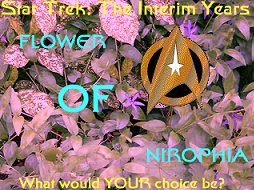 A plague threatens one of the largest colonies in the Federation. U.S.S. Urbani has a lead on the cure: a flower from the planet Nirophia. U.S.S. Sheffield is dispatched to Nirophia. The flower of Nirophia - the Silid - is sacred to the Nirophians. They refuse point-blank to give a sample.
A plague threatens one of the largest colonies in the Federation. U.S.S. Urbani has a lead on the cure: a flower from the planet Nirophia. U.S.S. Sheffield is dispatched to Nirophia. The flower of Nirophia - the Silid - is sacred to the Nirophians. They refuse point-blank to give a sample.
When a flower is stolen by a member of the Sheffield crew, the repercussions could have implications for the exploration in the quadrant. A courtmartial looms for all involved, especially for Captain Nathaniel Hawkins. As Commanding Officer he is responsible for the conduct of the crew under his command.
With his career in the balance, Hawkins' fate may reside in the hands of the brother-in-law he despises. There might be another solution: penitance. For A'Ochak and Hawkins this is a challenge that reminds them of the Starfleet credo that 'Weird is our business'. There are those who would like to see Hawkins' quest end in failure, for Nirophia is the keystone upon which expansion of the Federation driftward is based, and failure would open up so many interesting possibilities...
2314 - Year Three
Nightmares
Whilst en route to Starbase 77, Commander Nathaniel Hawkins is contacted by his old mentor, Captain Robert Carter. Contact has been lost with Federation science station PSI 4. No messages have been received for 72 hours, nor has any contact been had with the last starship sent to the base: Oberth class U.S.S. Urbani.
Science station PSI 4 is a classified top secret Federation facility that works on cutting edge psychological research. The base is run by Professor Thomas Creed, assisted by an old friend of Hawkins: V'Riel.
The clock is ticking for the crew of the U.S.S. Sheffield to discover the reason for the loss of contact. When the base is reached, the crew must face up to their own worst nightmare if they are to survive...
Therapy
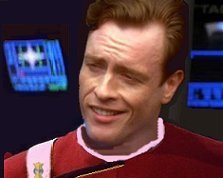
Following their ordeal at science station PSI 4, the crew of the U.S.S. Sheffield and the station survivors are all ordered to the medical facilities at Starbase 77. This should allow the crew to enjoy some rest and recreation.
For Captain Nathaniel Hawkins it is a chance to catch up with his eldest sister, Helen. The only problem for Nathaniel is that she is married to Maxwell Buckingham - Commodore and station commander. Hawkins' diplomatic skills are tested to the limit as Buckingham compares careers.
The survivors from science station PSI 4, and the crew of the U.S.S. Sheffield, are given counselling for their ordeals, but all might not be as it seems. Could someone be using the facility for their own benefits?
Scout
Stardate 11596.5.
Golonga V.
The planet.
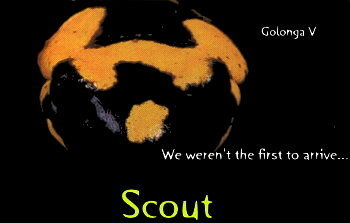 The USS Sheffield arrives to survey the swampy planet, after a preliminary pass by the USS Urbani suggests the planet is rich in minerals and potential plant resources. Commander Hawkins dispatches his XO, the Chief Geological Officer, Chief Medical Officer amongst an Away Team to investigate the planet.
The USS Sheffield arrives to survey the swampy planet, after a preliminary pass by the USS Urbani suggests the planet is rich in minerals and potential plant resources. Commander Hawkins dispatches his XO, the Chief Geological Officer, Chief Medical Officer amongst an Away Team to investigate the planet.
They weren't the first to arrive.
Whilst on the planet, the Federation meets face to face with the Sha'kurians - an amphibious race which has fought with the Romulans and Klingons for the past few decades. An attempt at first contact is made, to try to ensure the Federation starts off on the right foot.
A decision must be made.
The first contact leads to the deaths of some of the Away Team and the life of Ilani hangs in the balance. Now Captain Hawkins must decide whether the attack on his crew was the result of a misunderstanding, an accident, or a deliberate attack. The right decision could save the situation, the wrong decision could mean the first act of war.
Bridgehead
Stardate 11996.5.
Golonga V.
The decision.
Captain Nathaniel Hawkins is summoned to Starbase 77. Commodore Maxwell Buckingham has decided Hawkins' fate following the decisions he made at Golonga V, two years ago.
Colonisation.
The Sha'kurians have secured the planet Golonga V and the Federation wants to know more about them and their intentions. Hawkins is now considered to be the resident expert on Sha'kurians and first hand information is needed. The reused klingon intelligence is thought to have contributed to the events of last time.
Advancement into Sector 16447.
Golonga V has been secured. the Sha'kurians have set their eyes on worlds deeper into the sector. What are their intentions? Peaceful colonisation? or Invasion? Hawkins must make the decision. and make it in the knowledge of the consequences of his last decision. How will his crew react to another encounter with the Sha'kurians. Will some take matters into their own hands?
In the Pursuit of Justice
 The United Federation of Planets is a haven, a utopia of races, cultures and ideas all working together. For one man, this is paradise under siege from those who would exploit the idyll that has been created. Robert Hirst is a Federation Security agent. A cop. For Hirst, this is a constant battle against the scum that would undermine and destroy the paradise that took the founders of the Federation decades to achieve.
The United Federation of Planets is a haven, a utopia of races, cultures and ideas all working together. For one man, this is paradise under siege from those who would exploit the idyll that has been created. Robert Hirst is a Federation Security agent. A cop. For Hirst, this is a constant battle against the scum that would undermine and destroy the paradise that took the founders of the Federation decades to achieve.
Robert Hirst is a man on a mission: to solve the largest case of his career. This mission has cost him his partners, his marriage and the relationship with his son. Following in his father's footsteps, Robert is fighting to keep the Federation safe from those who would choose the wrong path. As Hirst watched his partners, and now his son in Starfleet, following the rules which allow only the symptoms of the underlying criminals to be treated. Hirst must sail as close to the wind as he dares to finish this last mission.
Bending the rules, following sources and building up the evidence, Robert Hirst must work his way through the underbelly of the Federation to find his final destination. Hirst must visit worlds that are far removed from the ideal at the heart of the Federation in order to save the soul of the organisation he has sworn to protect. Hirst doesn't know how far this path will take him, nor in what direction. When a man travels with no compass, there is no telling upon whose path he may cross...
Strangers in Dark Places
Information from their last mission has led the U.S.S. Sheffield back to Nimbus III. A dark secret from thirty years earlier threatens the peace in this side of the quadrant.
The true dark side of the Planet of Galactic Peace is uncovered. The deal struck in the corner of the Venus Bar, during the darkest hours of the colony. The deal saved the colony, but the legacy may condemn the planets future.
From the picturesque cottage where retired Federation diplomat St John Talbot now lives, to the mines which fuelled the growth of the colony from the beginning. Unseen sides of Nimbus III are revealed for the first time as the uncut, raw history of Nimbus III is told at last.
Finally, the story leads to the water processing facility and the man named Vikstaad Jaanz. For one member of the Sheffield crew, this will lead to a personal revelation that will turn their life upside-down, and have far-reaching repercussions for the Beta Quadrant.
Gaia
Felesor II. The Felesor colony was the discovery of the crew and passengers of the passenger vessel 'Rainbow Horizon' which set off in the early 2270s to find utopia beyond the frontier of the Federation. The freighter had over two hundred idealistic colonists onboard, looking for utopia. Their leader, Theibor, had sought to get away from the conflict with the Klingons, Romulans and other neighbouring races to the Federation that were in danger of polluting the haven that was the Federation. Theibor wanted to find a new Eden away from the Federation, politics and conflict. The Nimbus III colony was too artificial for his needs, and the quest of Doctor Sevrin had ended in disaster.
Felesor II was not quite the perfect Eden that Theibor had been seeking. Felesor II was rather like Africa in the dry season, rather than the lush green rainforest-like utopia the colonists had in mind, yet the planet at least had offered peace for the last thirty years. The colonists had eeked out a living on the planet, building a little eco-village out of the local plantlife, mud and rocks - supplemented by a handful of technology - had produced the hamlet of Sanctuary.
Felesor colony now faces the challenge of the frontier boundary catching up with their world. Forty years ago the Federation may have been a distant memory, now it is on the doorstep. The colony must decide whether to move onwards into the stars still further, or try and hold onto what they have here. The question also remains: what do they colonists have? how have they developed in the last 40 years and do they deserve to be left alone?
Secret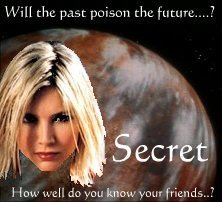
A secret from the past might end a friendship, cost a career and more...
Addiction
Tal Reno lies in a coma. His addiction to empathic events has finally ended in disaster. Has the Captain coerced this addict into indulging in his addiction in order to get results for the ship? Are the results worth the risks taken? Do the ends justify the means? Hawkins must utilise the skills of the Sheffield's most powerful telepath to try to retrieve Tal from the edge of the abyss, from which no man returns.
This is the story of Tal Reno: protigee, telempath extrodinaire and the ace up the sleeve of the U.S.S. Sheffield on more than one occasion. Follow the story of Petty Officer Reno from the abortive years at Starfleet Academy until the final last chance he was given by the Starfleet officer that believed that his talents could overcome his addiction. Can belief surpass dependency?
The fight is on to save the life of Tal Reno. Hawkins is prepared to go to any lengths to save the life of even one member of his crew. Can Reno be plucked from the abyss, or will the addiction of Tal Reno prove too powerful for even his friends to save him?
Gulag
Stardate 17995.5
nearly twenty years after the mission of the U.S.S. Sheffield ended.
Flash-forward to the mid-2330s with a prisoner in an anonymous gulag deep in the klingon backwaters. A shabby Ch'ramaki sits, reflecting on over 20 years imprisonment and the man who turned him in - Nathaniel Hawkins.
The son of a farming family reflects back on the fight against the klingons - and how he had to surrender to save his people. The rebellion led to millions massacred and the total annihilation of the culture, rapes to destroy the genome and create klingons. This only inspired the next generation of freedom fighter who worship the farmer's son as a martyr.
Twenty years of torture. Twenty years of never seeing his homeworld, of abuse, humiliation and solitude. The farmer's son saw many of his contemporaries die, broken by the klingon boot. Only he survives, toughened by his experiences as a youth and from his life as a freedom fighter. Blinded, emasculated and crippled from the torture and yet still the defiance of his people burns in the heart of the farmer's son.
See a different perspective on the klingons: They annex, they subjugate, they torture, they execute civilians and destroy cultures.
With the klingon empire trying to get back on its feet after decades of border wars, it is trying to expand and acquire resources. Ch'ramak was annexed by the order of Chancellor Azetbur in the last years of her reign - to protests from the Federation Council. This is the full story of the annexing, invasion and freedom fighter/terrorist fight back - and what happened next.
Get ready for a new slant. Forget the propaganda. Meet the neighbours.
details to be revealed later...













 2.04 – Our Generation – Sulu meets up with Koloth, who's not happy with the Khitomer Accords. The third Klingon archetype: the honourable noble. Koloth is what Kor evolved into in DS9, a noble who was descended from the blood of Kahless. William Campbell came across both in Trouble with Tribbles and Blood Oath as the aristocratic Klingon. The political beast who has connections through blood and his House. He knew Kang and Kor, but also was in with Kesh, Gorkon, Korrd and Chang. Why would he trust humans over these Klingons he's known for years when all Kirk did was put Tribbles onto his ship and humiliated him? The title comes from Gorkon's line "If there is to be a Brave New World, our generation is going to have the hardest time living in it". This story acts as a primer for what happens next...
2.04 – Our Generation – Sulu meets up with Koloth, who's not happy with the Khitomer Accords. The third Klingon archetype: the honourable noble. Koloth is what Kor evolved into in DS9, a noble who was descended from the blood of Kahless. William Campbell came across both in Trouble with Tribbles and Blood Oath as the aristocratic Klingon. The political beast who has connections through blood and his House. He knew Kang and Kor, but also was in with Kesh, Gorkon, Korrd and Chang. Why would he trust humans over these Klingons he's known for years when all Kirk did was put Tribbles onto his ship and humiliated him? The title comes from Gorkon's line "If there is to be a Brave New World, our generation is going to have the hardest time living in it". This story acts as a primer for what happens next... The year is 2312, nineteen years after the explosion of the Klingon key energy production facility on the moon Praxis. Barely months after the confrontation with the Romulans came to a violent and bloody head at Tomed, so the Klingon Empire is suddenly thrown into disarray by the assassination of Chancellor Azetbur.
The year is 2312, nineteen years after the explosion of the Klingon key energy production facility on the moon Praxis. Barely months after the confrontation with the Romulans came to a violent and bloody head at Tomed, so the Klingon Empire is suddenly thrown into disarray by the assassination of Chancellor Azetbur. The U.S.S. Sheffield crew beam down to a planet where there are ruins of a 21st Century-equivalent civilisation. Trees, wildlife - all have reclaimed the planet and the civilisation has apparently long gone. All that still exists are a neural network of aging computers, power sources and droids to maintain them.
The U.S.S. Sheffield crew beam down to a planet where there are ruins of a 21st Century-equivalent civilisation. Trees, wildlife - all have reclaimed the planet and the civilisation has apparently long gone. All that still exists are a neural network of aging computers, power sources and droids to maintain them. The Final Frontier is a realm of the fantastic, the mysterious and the terrible. For those crews of starships, their pioneers and explorers, history assures them of a place. For those lost along the way, there are monuments and services of remembrance. But what is there for those wounded by what they found, saw or experienced?
The Final Frontier is a realm of the fantastic, the mysterious and the terrible. For those crews of starships, their pioneers and explorers, history assures them of a place. For those lost along the way, there are monuments and services of remembrance. But what is there for those wounded by what they found, saw or experienced? A plague threatens one of the largest colonies in the Federation. U.S.S. Urbani has a lead on the cure: a flower from the planet Nirophia. U.S.S. Sheffield is dispatched to Nirophia. The flower of Nirophia - the Silid - is sacred to the Nirophians. They refuse point-blank to give a sample.
A plague threatens one of the largest colonies in the Federation. U.S.S. Urbani has a lead on the cure: a flower from the planet Nirophia. U.S.S. Sheffield is dispatched to Nirophia. The flower of Nirophia - the Silid - is sacred to the Nirophians. They refuse point-blank to give a sample.
 The USS Sheffield arrives to survey the swampy planet, after a preliminary pass by the USS Urbani suggests the planet is rich in minerals and potential plant resources. Commander Hawkins dispatches his XO, the Chief Geological Officer, Chief Medical Officer amongst an Away Team to investigate the planet.
The USS Sheffield arrives to survey the swampy planet, after a preliminary pass by the USS Urbani suggests the planet is rich in minerals and potential plant resources. Commander Hawkins dispatches his XO, the Chief Geological Officer, Chief Medical Officer amongst an Away Team to investigate the planet. The United Federation of Planets is a haven, a utopia of races, cultures and ideas all working together. For one man, this is paradise under siege from those who would exploit the idyll that has been created. Robert Hirst is a Federation Security agent. A cop. For Hirst, this is a constant battle against the scum that would undermine and destroy the paradise that took the founders of the Federation decades to achieve.
The United Federation of Planets is a haven, a utopia of races, cultures and ideas all working together. For one man, this is paradise under siege from those who would exploit the idyll that has been created. Robert Hirst is a Federation Security agent. A cop. For Hirst, this is a constant battle against the scum that would undermine and destroy the paradise that took the founders of the Federation decades to achieve.





